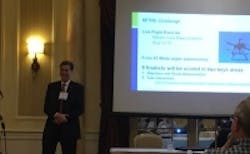[Page 2] Autonomous vehicles and UAVs hot topics at ROBOTICA 2016
Editor's note: This article is continued from page one.
Protecting the skies: Efforts and challenges in protecting our air space
During this presentation, Chris Jella, Senior Principal Engineer, MITRE Corporation (pictured) and Ted David, Advanced Systems and Technologies Executive, MIT Lincoln Labs, provided an overview about some of the issues that exist when it comes to deploying unmanned aerial systems (UAS), and how to protect the skies.
Jella began the talk, noting that when it comes to drones, there is an education problem. “There are a lot of people flying drones without safety or operating knowledge,” he said. He highlighted a study that was issued on August 16 of last year that said there were more than 70 close calls with small drones since August 1, while also noting that he believes there are at least three or four incidents per day.
Limitations of existing solutions for protecting the skies, he explained, include the fact that there are legal, cost, and technical obstacles, as well as the fact that commercial systems are unproven. He then provided information on the MITRE UAS Challenge, which attracted entries from a variety of innovators with technologies to detect and identify suspicious small drones (under 5 lbs) and interdict those that present a safety or security threat. From August 12-19, eight finalists will be scored on their ability to detect and determine threats, while safely interdicting.
Before the presentation turned into an open discussion, Ted David explained to the room that problems now are two-dimensional:
The level of complexity in the environment itself
The level of regret responding to a false alarm (The tolerance for false alarms)
"How do we take some of what has been done, and migrate that and apply it with new technologies to build end-to-end capabilities that can mitigate these types of threats?" he asked rhetorically.
During the Q&A, a number of interesting topics were discussed, but here are a few tidbits and quotes:
- "It’s going to be a huge event (if/when) a small UAS takes out a passenger airliner. Only a matter of time." (Jella)
- Cluttered scenes, in terms of UAVs and recognition, need to be studied further before solutions are "just applied" to it. (David)
- Problems arise when it comes to the costs involved in UAV and drone protection and research into safety. (Group)
- Local vs. national rules and regulations present a complex issue for all UAS operators. Could there be a transponder within the UAVs that alerts local authorities that my UAV has taken off? Similar to how a plane works? This would help. (Audience member)
Keynote | Protecting our skies | Intelligent and automated vehicles | Conclusion
About the Author

James Carroll
Former VSD Editor James Carroll joined the team 2013. Carroll covered machine vision and imaging from numerous angles, including application stories, industry news, market updates, and new products. In addition to writing and editing articles, Carroll managed the Innovators Awards program and webcasts.


